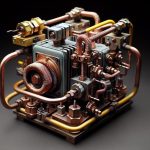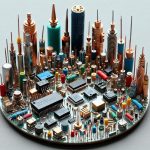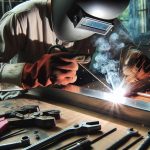Today, we’ll be exploring the intriguing comparison between two sources of light and heat: the welding arc and the sun.
On the surface, these may seem like polar opposites, but as we delve deeper, you’ll discover that they share more similarities than meets the eye.
- Both possess an intense energy that can be harnessed for various purposes.
- They both emit electromagnetic radiation – from ultraviolet to infrared rays in the case of a welding arc, and a wider spectrum in the case of the sun.
- The color temperature of a welding arc mirrors that of the sun’s fiery surface.
- Both play a significant role in our daily lives – powering our homes and constructing structures that shield us from nature’s elements.
- And most importantly, both require protective gear to safely observe or work with them.
Join us as we unravel these fascinating parallels between these two powerful sources of energy and gain a newfound appreciation for their force. So grab your safety goggles and let’s dive into this illuminating discussion.
Contents
- 1 Is A Welding Arc Compared To The Sun?
- 2 Comparing the Brightness of a Welding Arc and the Sun
- 3 Factors that Affect the Brightness of a Welding Arc
- 4 Potential Hazards of Welding Arcs and Safety Precautions
- 4.1 Utilize Personal Protective Equipment (PPE):
- 4.2 Ensure Adequate Ventilation:
- 4.3 Protect Your Ears:
- 4.4 Inspect Equipment Before Use:
- 4.5 Keep Your Workplace Clean:
- 4.6 Store Gas Cylinders Properly:
- 4.7 Avoid Exposure to UV Radiation:
- 4.8 Be Mindful of Electric and Magnetic Fields:
- 4.9 Have First Aid Knowledge and Equipment:
- 5 How Does the Brightness of a Welding Arc Compare to LED Light Bulbs?
- 6 Protecting Your Eyes from the Intense Light of a Welding Arc
- 7 Variations in Intensity and Brightness Depending on Distance and Current Flow
- 8 Conclusion
Is A Welding Arc Compared To The Sun?
When it comes to welding, there is one thing that stands out: the intense heat of a welding arc. In fact, it can reach a staggering temperature of up to 6,000°F, which is comparable to the surface temperature of the sun. Just like the sun, a welding arc releases immense heat and radiation, making it a potential hazard for those nearby without proper protection.
Another similarity between a welding arc and the sun is their brightness. While a welding arc may not be as bright as the sun, it can still cause damage to the eyes if proper eye protection is not worn. Additionally, the intensity of a welding arc can vary depending on factors such as distance and current flow, just like how the intensity of sunlight varies based on distance from the sun.
Another interesting comparison is with electrodes. Different types of electrodes emit different levels of brightness, similar to how different types of stars emit varying levels of light and radiation. This highlights the importance of selecting the right electrode for a specific welding job, just like how astronomers choose the appropriate telescope for observing different stars.
Furthermore, arc lamps use electric arcs to create light, similar to how welding arcs use electric arcs to create heat and light. This shows that the concept of using electric arcs for lighting has been utilized in various industries, including welding and lighting technology.
Comparing the Brightness of a Welding Arc and the Sun
The brightness of a welding arc is significantly higher than that of the sun. At a distance of 1 meter, the intensity level of a welding arc is approximately half that of the sun.
However, during the summer months, when the sun’s intensity is at its peak, the intensity of a welding arc may even exceed that of the sun at noon.
This makes it crucial for welders to take proper precautions to safeguard their eyes and skin from the intense light and heat emitted by a welding arc.
To further demonstrate this comparison, let’s refer to the following table:
| Welding Arc | Sun | |
| Brightness at 1 meter | Roughly half of sun’s intensity | 100% |
| Brightness during summer months | Greater than sun’s intensity at noon | Hazardous to human health |
As shown in the table, the brightness of a welding arc is significantly greater than that of the sun, particularly during the summer months.
This is due to the fact that a welding arc produces concentrated light in a small area, while the sun’s light is dispersed over a larger area.
In fact, direct exposure to a welding arc can result in permanent eye damage, while looking directly at the sun can cause temporary blindness.
Factors that Affect the Brightness of a Welding Arc
The brightness of a welding arc can be influenced by a variety of factors, including the type of welding process, welding parameters, and materials being welded.
However, in comparison to the sun, these factors have a relatively minor impact on the brightness of a welding arc due to the sun’s significantly higher temperature and larger size.
Other factors that can affect the brightness of a welding arc include the type of electrode used, current flow, and distance from the arc. Different types of electrodes produce varying levels of brightness, with some being more efficient at producing light than others.
The amount of current flowing through the arc also plays a role in its brightness, with higher currents resulting in a brighter arc.
Furthermore, the distance from the welding arc also impacts its overall brightness. The closer one is to the arc, the brighter it appears due to the concentration of light. However, this also means that proper eye protection must be worn to prevent harm to the eyes.
In addition to these factors, the type of shielding gas used, welding process employed, and material being welded can also impact the brightness of a welding arc. Different welding processes and materials require varying levels of energy, which can affect the brightness of the arc.
In contrast, the sun’s brightness is not affected by these factors as it inherently has a much higher temperature and larger size.
Potential Hazards of Welding Arcs and Safety Precautions
Welders must take proper precautions to protect themselves from potential hazards while working with welding arcs.
Failure to do so can result in severe injuries or even death. Some of the most common hazards associated with welding arcs include electric shock, fire hazards, exposure to fumes and gases, hearing impairment, eye damage, and exposure to electric and magnetic fields.
To ensure the safety of welders, here are some essential safety precautions that should be followed when working with welding arcs:
Utilize Personal Protective Equipment (PPE):
Welders must wear appropriate PPE at all times to safeguard themselves from potential hazards. This includes wearing fire-resistant clothing, gloves, and boots to avoid burns caused by sparks and heat.
Additionally, a welding helmet equipped with a filter lens must be worn to protect the eyes from intense light and infrared radiation.
Ensure Adequate Ventilation:
Proper ventilation is crucial in preventing exposure to welding fumes and gases.
This can be achieved by working in a well-ventilated area or using local exhaust ventilation systems.
Protect Your Ears:
The loud noise produced during welding can lead to permanent hearing impairment.
Therefore, it is necessary to wear ear protection to reduce noise levels and safeguard the ears.
Inspect Equipment Before Use:
Before starting any welding project, it is essential to thoroughly inspect the equipment for any damages or defects.
This will help prevent potential injuries caused by equipment failure.
Keep Your Workplace Clean:
A cluttered workplace can lead to accidents and injuries.
Thus, it is crucial to keep the work area clean and free of debris or flammable materials.
Store Gas Cylinders Properly:
Gas cylinders used for welding must be stored in a well-ventilated area away from heat sources to prevent explosions.
Avoid Exposure to UV Radiation:
Proper eye protection that filters out harmful UV radiation from the welding arc must be worn by welders.
Prolonged exposure to UV rays can cause severe eye damage.
Be Mindful of Electric and Magnetic Fields:
The electric and magnetic fields created by welding arcs can interfere with pacemakers or other medical devices.
Welders with these devices should take necessary precautions or avoid welding altogether.
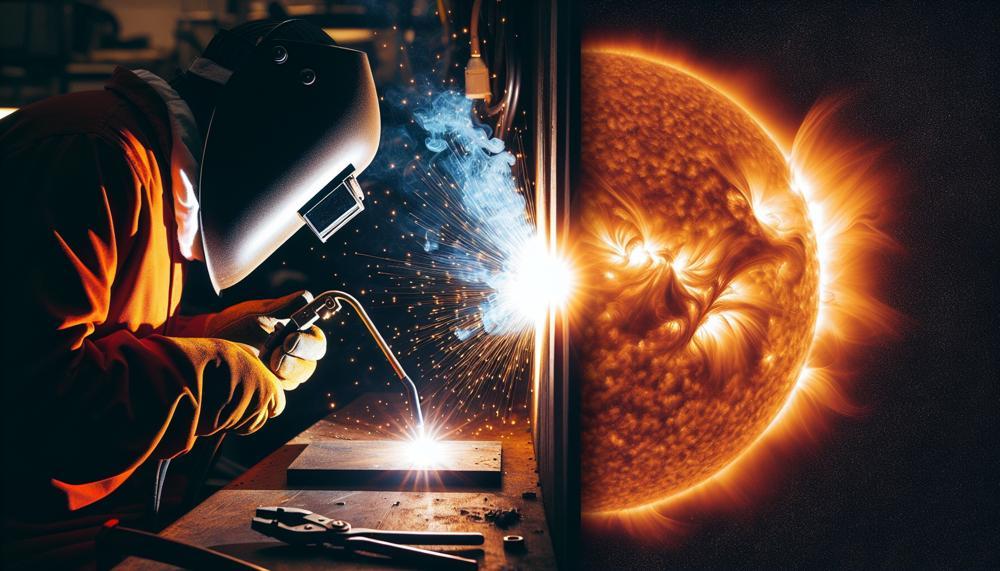
Have First Aid Knowledge and Equipment:
Welders should have basic first aid knowledge and appropriate equipment on hand in case of minor injuries. In case of more severe injuries, it is essential to consult trained medical personnel.
In comparison to the scorching heat and blinding light of the sun, the hazards posed by welding arcs are relatively low.
While welding arcs can cause electric shock, fire hazards, exposure to fumes and gases, hearing impairment, eye damage, and exposure to electric and magnetic fields, the sun’s intense heat and light can result in more severe and widespread damage, such as skin burns and eye damage.
How Does the Brightness of a Welding Arc Compare to LED Light Bulbs?
When it comes to brightness, welding arcs easily outshine LED light bulbs. In fact, welding arcs can produce up to 10,000 times more lumens than the Sun, which is quite impressive considering that LED light bulbs typically only produce around 800-1500 lumens.
This significant difference in brightness can be attributed to the intense heat and light emitted by welding arcs, which are crucial for melting and joining metals.
To put this into perspective, let’s take a closer look at some specific numbers.
In industrial settings, MIG welding arcs are commonly used and can range from 10,000 to 100,000 lumens depending on the tungsten size and amperage used. That means welding arcs can be up to 20 times brighter than the Sun.
On the other hand, a standard LED light bulb used for household lighting produces around 800-1500 lumens.
The high lumen output of welding arcs is not only essential for their functionality but also for the safety and comfort of welders. Working in close proximity to a bright welding arc for extended periods can cause eye strain and glare.
However, the intense brightness of welding arcs also offers advantages such as better visibility and accuracy during welding, resulting in cleaner and more precise welds.
Protecting Your Eyes from the Intense Light of a Welding Arc
Protecting your eyes from the intense light of a welding arc is crucial to ensure long-term eye health. Welding arcs emit high levels of ultraviolet (UV) and infrared (IR) radiation, which can cause damage to the eyes if not properly protected. In fact, welding arcs can emit up to 10,000 times more intense light than the sun, making them a potential hazard for welders.
To avoid eye injury, it is recommended to wear proper eye protection while welding. This includes filtered safety glasses, goggles, or a welding helmet specifically designed to block harmful UV and IR rays. Different welding processes may require different levels of protection, so it is important to refer to safety guidelines and regulations when choosing eye protection.
It is also essential to note that even with proper eye protection, prolonged exposure to bright welding arcs can still lead to eye strain and fatigue. To alleviate this issue, it is recommended to take frequent breaks and look away from the welding arc periodically.
Compared to the sun, welding arcs emit much brighter light and a higher concentration of harmful UV and IR radiation. Therefore, welders must take necessary precautions and wear appropriate eye protection while working.
| Sun | Welding Arc | |
| Light Intensity | Less intense | More intense (up to 10,000 times brighter) |
| Radiation | UV and IR rays | UV and IR rays (higher concentration) |
| Recommended Eye Protection | Sunglasses/goggles | Filtered safety glasses, goggles, or welding helmet |
| Potential for Eye Strain | Minimal | Higher risk due to brightness and concentration of radiation |
| Recommendations | Limit exposure, wear sunglasses/goggles when necessary | Wear appropriate eye protection, take frequent breaks to alleviate eye strain |
To protect your eyes from the intense light of a welding arc, it is crucial to understand the potential dangers and take proper precautions. Welding arcs emit high levels of ultraviolet (UV) and infrared (IR) radiation, which can cause damage to the eyes if not properly protected. In fact, welding arcs can emit up to 10,000 times more intense light than the sun, making them a potential hazard for welders.
To avoid eye injury, it is recommended to wear proper eye protection while welding.
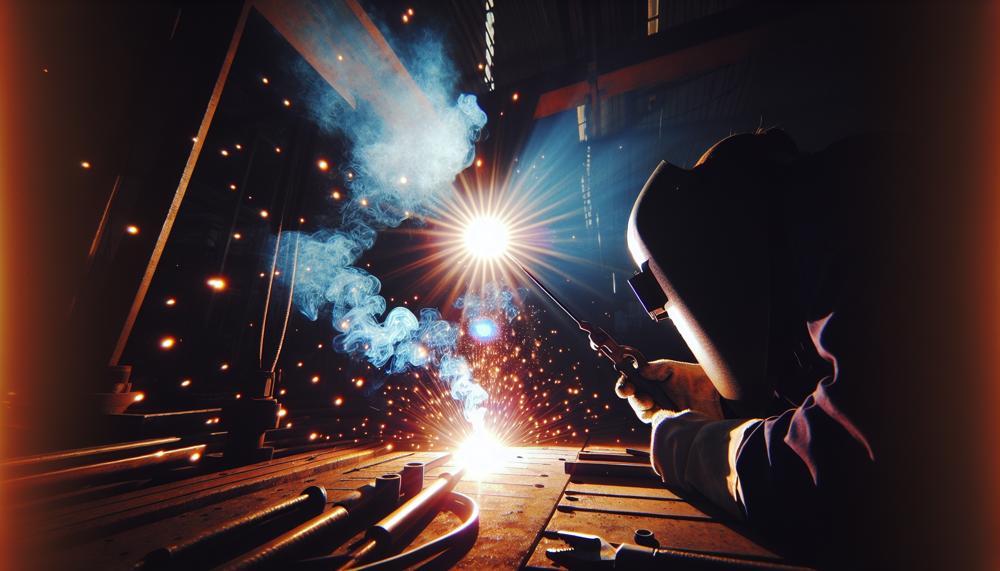
Variations in Intensity and Brightness Depending on Distance and Current Flow
The quality of welds and the safety of welders are significantly impacted by variations in intensity and brightness of a welding arc. It is crucial to understand how distance and current flow affect these factors for successful welds and to protect oneself from the intense light and heat emitted by these powerful sources.
Distance plays a critical role in determining the intensity and brightness of a welding arc. As the distance between the arc and the workpiece increases, the intensity and brightness decrease. This is due to the light spreading out as it travels, resulting in a larger, less concentrated area of light. Therefore, the closer the arc is to the workpiece, the brighter it will be.
In addition, current flow also affects the intensity and brightness of a welding arc. The higher the current flow, the brighter the arc will be. This is because more current produces a more intense and concentrated arc, resulting in higher levels of heat and light emission.
However, it is essential to exercise caution when increasing current flow as excessive amounts can lead to melting or warping of materials.
When comparing welding arcs’ intensity and brightness to that of the sun, significant differences can be observed. Welding arcs can produce up to 200,000 lumens of light, which is significantly brighter than sunlight.
Moreover, welding arcs emit high levels of UV radiation, making it crucial for welders to use appropriate safety gear to protect their eyes. In contrast, sunlight emits lower levels of UV radiation due to our atmosphere’s natural filters.
Conclusion
In conclusion, while the comparison between a welding arc and the sun may seem far-fetched, our exploration in this blog post has revealed surprising similarities between these two sources of light and heat.
Both possess intense energy and emit electromagnetic radiation, playing crucial roles in our daily lives. And just like how we need protective gear to shield ourselves from the sun’s harmful rays, welders also require proper safety measures when working with a welding arc.
Through this discussion, we have gained a deeper appreciation for both the welding arc and the sun. We now understand that although a welding arc may not be as bright as the sun, it can still cause damage if not handled carefully.
Furthermore, we have learned how factors like distance and current flow can impact the intensity and brightness of a welding arc, underscoring the importance of understanding these variables for successful welds and personal safety.
Overall, this comparison has shed light on the fascinating world of welding while emphasizing the significance of taking precautions when dealing with powerful sources of energy like a welding arc or the sun.



